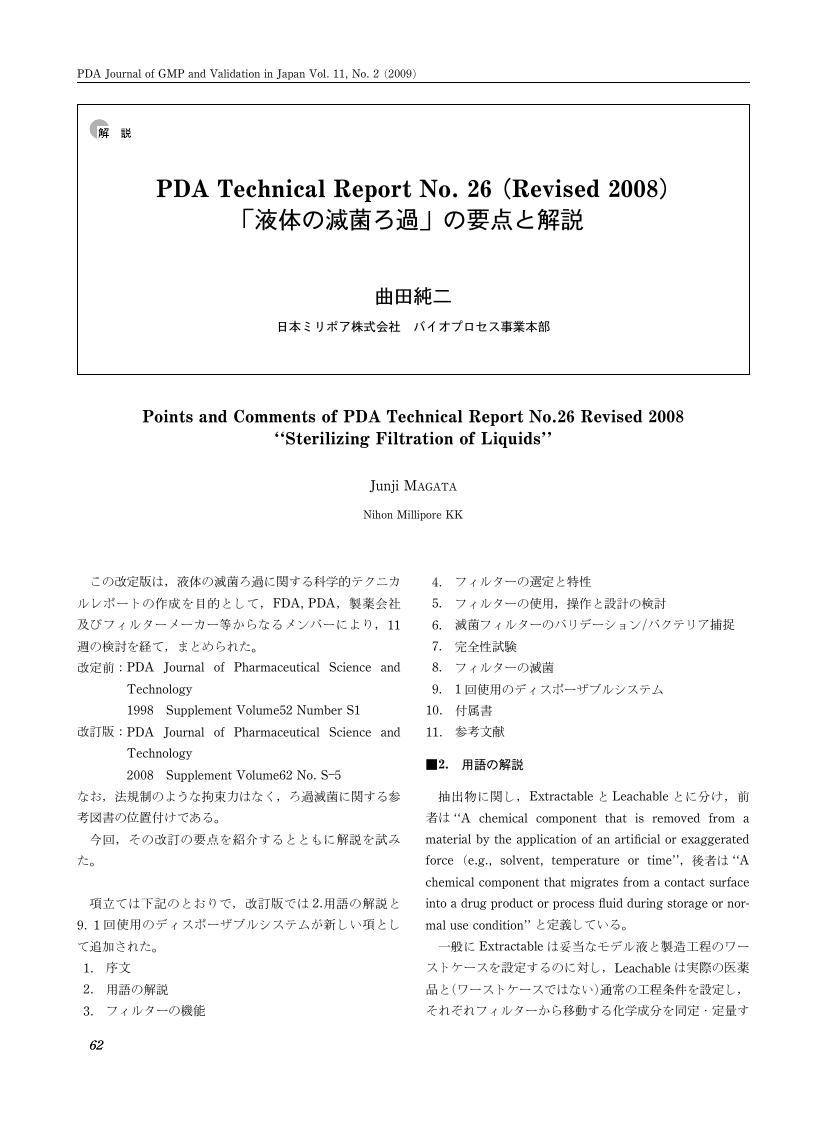- 著者
- 曲田 純二
- 出版者
- 一般社団法人日本PDA製薬学会
- 雑誌
- 日本PDA学術誌 GMPとバリデーション (ISSN:13444891)
- 巻号頁・発行日
- vol.11, no.2, pp.62-66, 2009 (Released:2010-10-02)
- 著者
- 浦久保 知也 大場 徹也 岡村 元義 金田 伸一 川俣 治 塩見 哲次 重松 弘樹 菅谷 真二 菅原 敬信 曲田 純二 丸山 裕一 元木 政道
- 出版者
- 一般社団法人日本PDA製薬学会
- 雑誌
- 日本PDA学術誌 GMPとバリデーション (ISSN:13444891)
- 巻号頁・発行日
- vol.10, no.2, pp.23-36, 2008 (Released:2009-12-04)
- 参考文献数
- 6
The Bio-Virus Safety Committee (BV-Committee), one of the committees of the Parental Drug Association Japan (PDA Japan), has discussed various concerns on biopharmaceuticals from scientific, technical and regulatory perspective. One of the most significant concerns is the risk of contamination of infectious agents into manufacturing process and products. This risk should be addressed, as required per the international regulations, by minimizing to use raw materials sourced from animal origin and by performing viral clearance studies in order to evaluate capability of purification process to reduce and/or inactivate known and/or adventitious viruses. BV-Committee reported the conclusions of discussion how to prepare and qualify cell bank system as one of raw materials and how much Log Reduction Value (LRV) should be targeted in virus clearance studies in the 13th annual conference of the PDA Japan in 2005 and published in the PDA Journal1). Since 2007, BV-Committee discussed the practical experimental procedures for viral clearance studies and reported the conclusions in the 14th annual conference of the PDA Japan in 2007 and reported in the PDA journal2). In the report, standardized and practical experimental procedures for viral clearance studies were proposed, considering not only requirements for submission to the regulatory agencies but also experimental technique. In addition, trouble shooting based upon the actual experience of the members, information regarding Contract Research Organizations (CROs), references of international guidelines, and worksheets for viral clearance study are provided. Since 2008, BV-Committee has discussed how the Quality Risk Management (QRM) approach can be applied to manufacturing and quality control of biopharmaceuticals through a case study of a recombinant monoclonal antibody. The conclusion was presented in the 15th annual conference of the PDA Japan in 2008. In the case study, we supposed that viral contamination and residual process related impurities could be the source of quality risk. Risk assessment practice was performed, focusing on the following five categories, “Cell Banking”, “Cell Culture”, “Purification”, “Medium/Buffer Preparation” and “Viral Inactivation and Filtration”. In certain items, where the assessment showed higher risk, preventative measures to control the risk were discussed.
1 0 0 0 OA ヘルスケア製品 (医薬品・体外診断薬・医療用具) の無菌操作法におけるろ過滅菌
- 著者
- 曲田 純二
- 出版者
- 一般社団法人日本PDA製薬学会
- 雑誌
- 日本PDA学術誌 GMPとバリデーション (ISSN:13444891)
- 巻号頁・発行日
- vol.4, no.2, pp.121-126, 2002 (Released:2006-07-18)
- 参考文献数
- 5
Regulatory agencies in Japan, US and EU have been requiring validation for sterilizing filtration as part of aseptic processing to pharmaceutical industry. ISO 13408 offers guidance to filter users concerning general requirements for set up, validation and routine operation of a sterilizing filtration process, to be used for aseptic processing of health care products. ISO/TC 198/WG9 has been working for definition of requirements for filter selection, fluid specific selection criteria, filtration process, system design, routine process, documentation, maintenance &change control and operator training. At present, it is a step of Draft International Standard.
